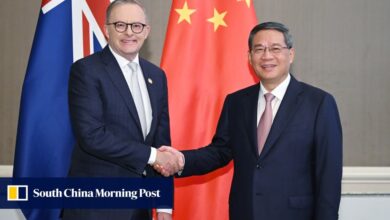Yarra Capital Management’s Tim Toohey expects a 10pc return for the ASX and no recession in 2024

And that growth can help propel large caps on the ASX to a 10 per cent gain this year. Yarra also tips a 15 per cent return from small caps, as investors turn away from the defensive stocks favoured last year, and towards sectors to benefit from what Toohey believes is the early start of an investment cycle. That cycle includes industrials, materials, financials, tech and even the beleaguered real estate investment trust sector.
Toohey acknowledges much of his outlook is dependent on the Fed’s actions, but sees little that will prevent his predicted rate cuts coming. Persistently stubborn services inflation and robust wage growth are two factors frequently cited as hurdles to cuts. But Toohey says US wage growth has been moderating in trend terms, and he’s comfortable that services inflation is set to ease materially.
In Australia, Toohey expects the Reserve Bank to cut in August and November as inflation moderates. That first cut might come sooner than many expect given inflation is only like to get back into the RBA’s target band by the end of the year. But Toohey does expect Australia’s easing cycle will be relatively shallow, as the Australian economy is propelled along by four key tailwinds: strong commodity prices; savings buffers and rising asset prices that let older, wealthier households continue spending even as younger, indebted households suffer a disproportionate beating; population growth that may well surprise to the upside again this year; and the big backlogs of construction activity Australia is working through.
The sheer size of these backlogs is surprising. Many economists have been rightly focused on the parlous state of housing approvals. But Toohey points out the backlog of non-residential construction work is equivalent to 7 per cent of GDP, while the backlog of engineering construction (led by roads, railways, electricity and mining) equates to 16 per cent of GDP.
Toohey says late 2023 data points are also encouraging heading into this year, including further evidence of moderating inflation and another jump in commodity prices against a backdrop of a weaker US dollar and solid global demand, particularly from emerging economies such as India, Vietnam, Mexico and parts of Eastern Europe, where industrial production is surging; Toohey argues this is the big good news story global economists and strategists have missed.
Australia is also likely to see further fiscal stimulus. The Albanese government, for example, is holding firm to its promise to deliver the stage three income tax cuts, which Yarra estimates are equivalent to 1.1 per cent of disposable income, although this will skew to wealthier households and Toohey expects half of the benefit will be saved.
But Yarra does see support for lower and middle income households coming in the first half of the year, as has been widely foreshadowed.
So what could do wrong? Toohey says the big risk in the US is not a reemergence of inflationary pressures but the world’s biggest economy hitting an early year air pocket that could be compounded if investment dries up as businesses fret about changes to programs like in Inflation Reduction Act under a Trump presidency.
Locally, Toohey concedes the RBA could cut later than he expects given concerns around wage growth, asset prices and the strength of house prices. But by the end of the year, with disinflationary forces more evident and central banks around the world cutting rates, Toohey remains confident the RBA will join the easing party.





